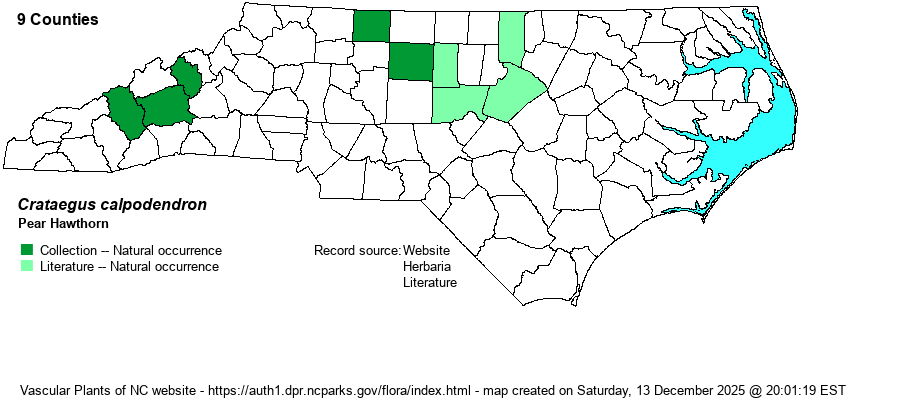| Author | (Ehrhart) Medikus | |
| Distribution | Widely scattered and poorly known, but known to occur at a handful of sites/counties in the Mountains and east to Guilford and Wake counties.
This is a Midwestern and somewhat Northern species ranging east to NY, central NC, and central AL. Over most of its range in the eastern states, it has been confirmed by specimens in relatively few counties, perhaps to being overlooked.
| |
| Abundance | Rare to uncommon, but poorly known and easily overlooked, despite being a long-known and described species. This is a long-known species instead of so many recent splits or re-described hawthorn species. This a Watch List species. | |
| Habitat | This is a species growing mainly in the forest shade, unlike most hawthorns. It favors mesic slopes, at times near creeks, ravines, and other reasonably shaded and semi-moist sites, particularly over high pH soils. The Wake plants grew in mafic soil on Adam Mountain. |
| Phenology | Blooms in May and June, and fruits from September to October. | |
| Identification | This is a small tree, to about 15 feet high, with often wide-spreading branches, yielding a crown that is usually wider than tall. The leaves are rather large for a hawthorn, often 3-3.5 inches long and nearly as wide. They are strongly serrate, widely elliptic to ovate, and most leaves have noticeable hairs on the surfaces and the petioles. The flowers are among the latest blooming of all NC Crataegus species; each inflorescence typically has at least 12 flowers. The Digital Atlas of the Virginia Flora states: “The pubescent leaves (below) and hairy, broadly compound inflorescences help to distinguish this species.” For additional characters, see Lance (2014) and Weakley (2018). As with most hawthorns, if you stumble onto this species, you likely will need to key it out on the spot, or snatch a twig and key it out later for identification. | |
| Taxonomic Comments | This is one of the few NC hawthorns that were included as a good species in RAB (1968). A few old references do list several varieties for it.
| |
| Other Common Name(s) | Late Hawthorn | |
| State Rank | S2? | |
| Global Rank | G5 | |
| State Status | W7 | |
| US Status | | |
| USACE-agcp | | |
| USACE-emp | | |

